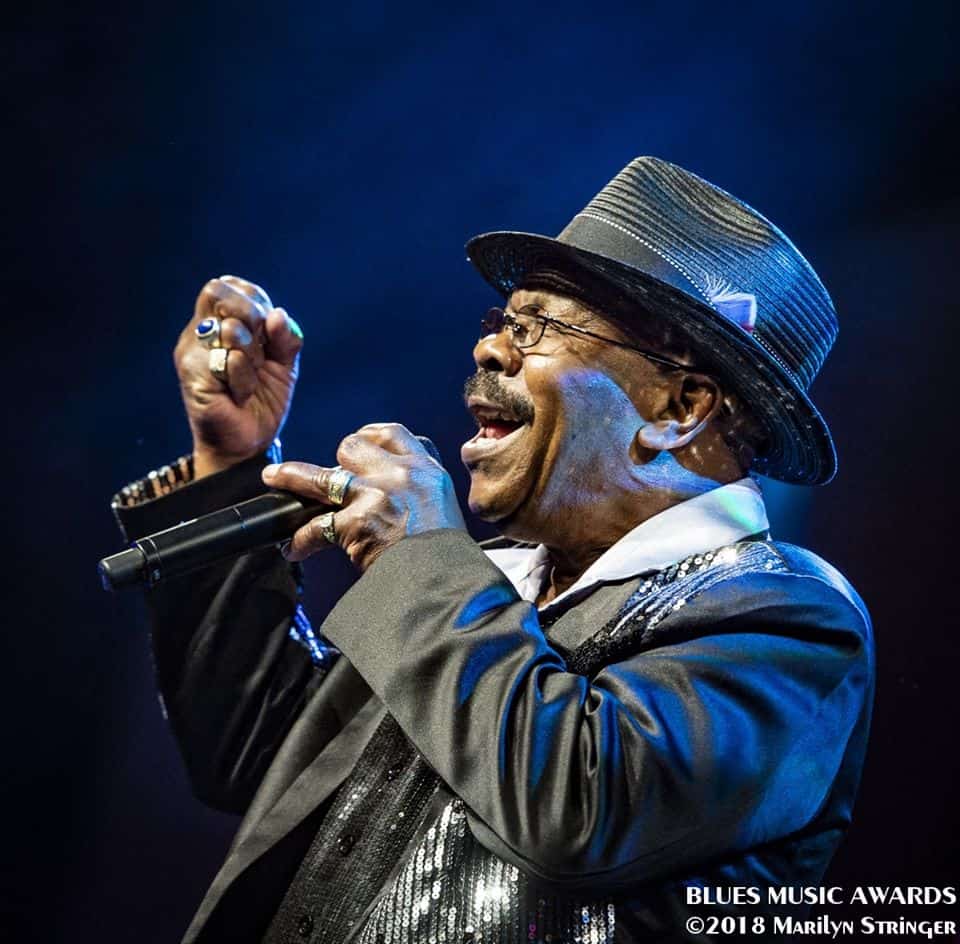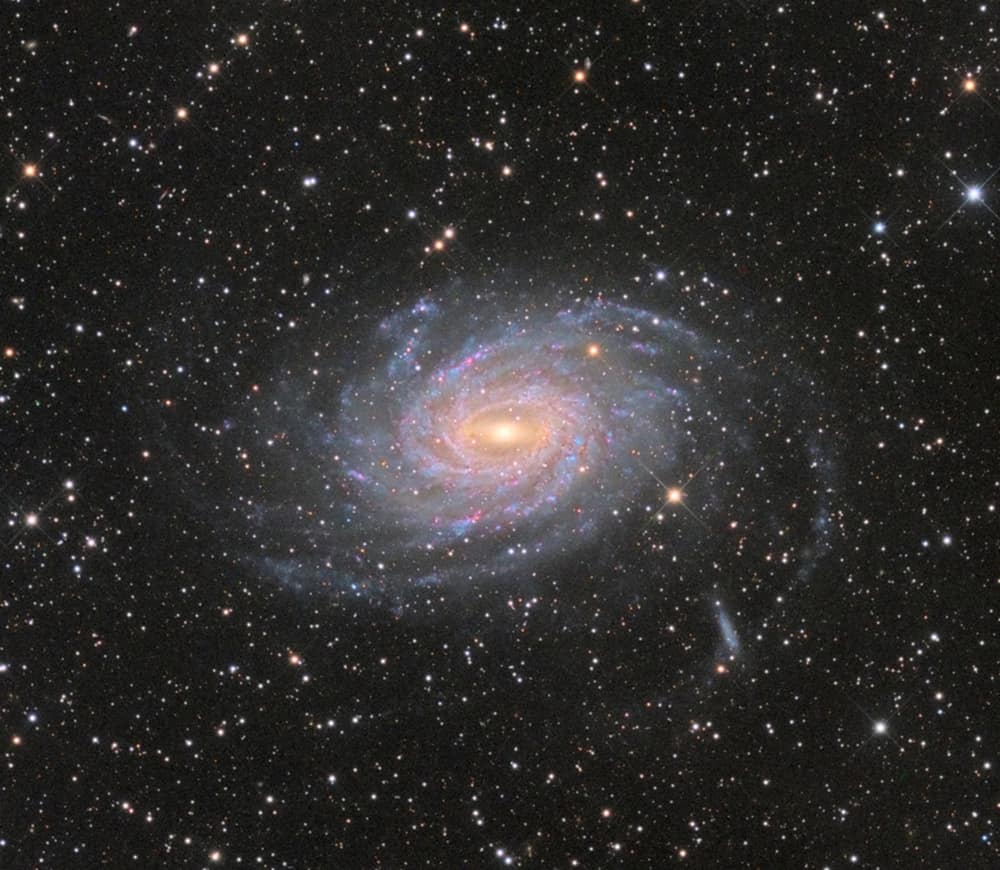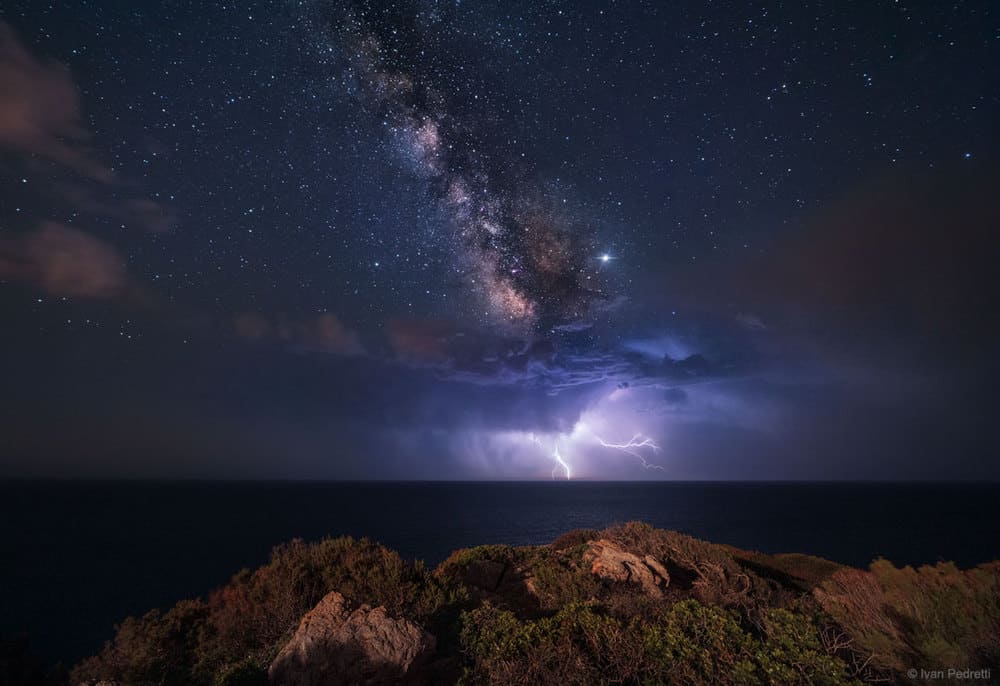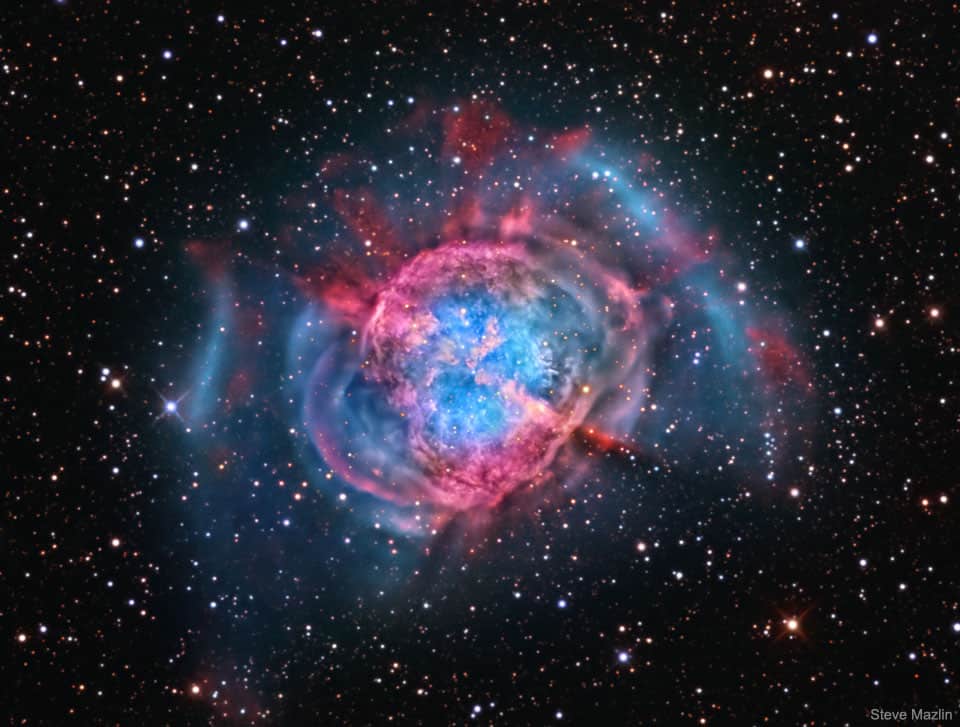Blog
Wee Willie Walker Memorial
I forgot that this wonderful soul singer passed on recently, November 19th 2019 in St Paul. My New Orleans group BEAU KOO JACKS needs a singer for an upcoming engagement, and I thought oh call Wille. Then it struck me that I noticed his recent obit. Wow another great loss like that of the Seattle based Sharon Jones and Charles Bradley. Wille had done the annual Fat Tuesday gig with the BKJ at Neumanns a number of years ago; and even though he didn’t really didn’t know all of the Mardi Gras material, he knocked it out of the park.
Thank You Wille you da man!

Beautiful spiral galaxy NGC 6744 is nearly 175,000 light-years across, larger than our own Milky Way. It lies some 30 million light-years distant in the southern constellation Pavo and appears as only a faint, extended object in small telescopes. We see the disk of the nearby island universe tilted towards our line of sight in this remarkably detailed galaxy portrait, a telescopic view that spans an area about the angular size of a full moon. In it, the giant galaxy’s elongated yellowish core is dominated by the light from old, cool stars. Beyond the core, grand spiral arms are filled with young blue star clusters and speckled with pinkish star forming regions. An extended arm sweeps past a smaller satellite galaxy (NGC 6744A) at the lower right. NGC 6744’s galactic companion is reminiscent of the Milky Way’s satellite galaxy the Large Magellanic Cloud.

José Monje Cruz (5 December 1950 – 2 July 1992), better known by his stage name Camarón de la Isla (Spanish: Shrimp of the Island), was a Spanish Romani flamenco singer. Considered one of the all-time greatest flamenco singers, he was noted for his collaborations with Paco de Lucíaand Tomatito, and the three of them were of major importance to the revival of flamenco in the second half of the 20th century.
He was born in San Fernando, Cádiz, Spain, into a Romani family, the second of eight children. His mother was Juana Cruz Castro, a basket weaver (“La Canastera”), whose gift of singing was a strong early influence.
His father, Juan Luis Monje, was also a singer as well as a blacksmith, and had a forge where Camarón worked as a boy. His uncle José nicknamed him Camarón (Spanish for “Shrimp”) because he was blonde and fair skinned.
When his father died of asthma, while still very young, the family went through financial hardship. At the age of eight he began to sing at inns and bus stops with Rancapino to earn money. At sixteen, he won first prize at the Festival del Cante Jondo in Mairena de Alcor. Camarón then went to Madrid with Miguel de los Reyes and in 1968 became a resident artist at the Tablao Torres Bermejas where he remained for twelve years.
more...Egberto Amin Gismonti (born December 5, 1947 in Carmo, state of Rio de Janeiro) is a Brazilian composer, guitarist and pianist.
Gismonti was born in the small city of Carmo, state of Rio de Janeiro, Brazil, into a musical family. His mother was from Sicily and his father was from Beirut, Lebanon. At the age of six, he started studying the piano at the Brazilian Conservatory of Music. After studying the classical repertoire in Brazil for fifteen years, he went to Paris to delve into modern music. He studied with Nadia Boulanger (1887–1979), after acceptance as a student by the composer Jean Barraqué, a student of Anton Webern and Schoenberg. Boulanger encouraged Gismonti to write the collective Brazilian experience into his music.
Gismonti is a self-taught guitarist. After returning to Brazil, he designed guitars with more than six strings, expanding the possibilities of the instrument. Approaching the fretboard as if it were a keyboard, Gismonti gives the impression that there is more than a single guitar player. Gismonti’s sojourn in the Xingu region of the Amazon basin made a lasting impression. This is documented musically in tunes like “Yualapeti” and “Sapain” (Yualapeti shaman, Sapain) and in the recordings Dança das Cabeças (Dance of the Heads, 1977), Sol do Meio-Dia (Noon Sun, 1978), which he dedicated to the Xingu, and Duas Vozes (Two Voices, 1984).
The musical career of Gismonti spans five decades. The major phases are distinguished by record company, the ensemble format, and the musical collaborators. The most important ensembles are his Brazilian group Academia de Danças, including Mauro Senise (saxophone and flutes), Zeca Assumpção (bass) and Nenê (Realcino Lima Filho, drums and percussion), the duo with Naná Vasconcelos (percussion), and the trio with Charlie Haden (bass) and Jan Garbarek (saxophone). Dança das Cabecas, the first ECM record, was nominated ‘Album of the Year’ by Stereo Review and received the 1977 Großer Deutscher Schallplattenpreis.
more...John Weldon “J. J.” Cale (December 5, 1938 – July 26, 2013) was an American guitarist, singer, and songwriter. Though he avoided the limelight, his influence as a musical artist has been widely acknowledged by figures such as Mark Knopfler, Neil Young and Eric Clapton, who described him as “one of the most important artists in the history of rock”. He is considered to be one of the originators of the Tulsa Sound, a loose genre drawing on blues, rockabilly, country, and jazz.
Many songs written by Cale have been recorded by other acts, including “After Midnight” and “Cocaine” by Eric Clapton; “Call Me the Breeze” by Lynyrd Skynyrd, John Mayer, Johnny Cash, and Bobby Bare; “Clyde” by Waylon Jennings and Dr. Hook; “I Got The Same Old Blues” by Captain Beefheart, Lynyrd Skynyrd, Freddie King, and Bryan Ferry; “Travelin’ Light” and “Ride Me High” by Widespread Panic; and “Magnolia” by Poco, Pat Travers, Beck, Lucinda Williams, Iron & Wine, José Feliciano, Ben Bridwell, John Mayer with Eric Clapton, Joan Shelley, and Sadie Johnson; as well as “Bringing It Back” covered by Kansas.
In 2008, Cale, along with Clapton, received a Grammy Award for their album The Road to Escondido.
more...Art Davis (December 5, 1934 – July 29, 2007) was a double-bassist, known for his work with Thelonious Monk, John Coltrane, Dizzy Gillespie, McCoy Tyner and Max Roach.
Davis was born in Harrisburg, Pennsylvania, where he began studying the piano at the age of five, switched to tuba, and finally to bass while attending high school. He studied at Juilliard and Manhattan School of Music but graduated from Hunter College.
As a New York session musician, he recorded with many jazz and pop musicians and also in symphony orchestras such as the New York Philharmonic and Los Angeles Philharmonic. He recorded with Dizzy Gillespie, Max Roach, and John Coltrane among other jazz musicians. Art Davis was a professor at Orange Coast College.
Davis is also known for starting a legal case that led to blind auditions for orchestras.
Davis earned a Ph.D. in clinical psychology from New York University in 1982. He moved in 1986 to southern California, where he balanced his teaching and practicing of psychology with jazz performances.
Davis died on July 29, 2007, from a heart attack. He was survived by two sons and a daughter.
more...Richard Wayne Penniman (born December 5, 1932), known as Little Richard, is an American musician and singer-songwriter.
An influential figure in popular music and culture for seven decades, Penniman’s most celebrated work dates from the mid-1950s, when his dynamic music and charismatic showmanship laid the foundation for rock and roll. His music also played a key role in the formation of other popular music genres, including soul and funk. Penniman influenced numerous singers and musicians across musical genres from rock to hip hop; his music helped shape rhythm and blues for generations to come, and his performances and headline-making thrust his career right into the mix of American popular music.
Penniman has been honored by many institutions. He was inducted into the Rock and Roll Hall of Fame as part of its first group of inductees in 1986. He was also inducted into the Songwriters Hall of Fame. He is the recipient of a Lifetime Achievement Award from the Recording Academy and a Lifetime Achievement Award from the Rhythm and Blues Foundation. In 2015, Penniman received a Rhapsody & Rhythm Award from the National Museum of African American Music for his key role in the formation of popular music genres, influencing singers and musicians across genres from Rock to Hip-Hop, and helping to bring an end to the racial divide on the music charts changing American culture significantly. Little Richard’s “Tutti Frutti” (1955) was included in the National Recording Registry of the Library of Congress in 2010, which stated that his “unique vocalizing over the irresistible beat announced a new era in music”. Little Richard was born Richard Wayne Penniman on December 5, 1932, in Macon, Georgia. He was the third of twelve children of Leva Mae (née Stewart) and Charles “Bud” Penniman. His father was a church deacon who sold bootlegged moonshine on the side and owned a nightclub, the Tip In Inn. His mother was a member of Macon’s New Hope Baptist Church. Initially, Penniman’s first name was supposed to have been “Ricardo” but an error resulted in “Richard” instead. The Penniman children were raised in a neighborhood of Macon called Pleasant Hill.In childhood, he was nicknamed “Lil’ Richard” by his family, because of his small and skinny frame. A mischievous child who played pranks on neighbors, Penniman began singing in church at a young age.
more...
Carl Donnell “Kansas” Fields (December 5, 1915, Chapman, Kansas – August 3, 1995, Chicago) was an American jazz drummer.
Fields played in Chicago beginning in the late 1920s, and worked with King Kolax and Jimmie Noone in the 1930s. In 1940 he joined Roy Eldridge‘s group for a year; he returned to play with Eldridge again later in the 1940s. He briefly led his own ensemble and played with Ella Fitzgerald and Benny Carter before joining the Marines during World War II. After the war he played with Cab Calloway, Claude Hopkins, Sidney Bechet, Dizzy Gillespie, and Eldridge again before the close of the decade.
He led another group of his own early in the 1950s, then played with Mezz Mezzrow in Europe in 1953. Fields ended up staying in Europe for more than a decade; he relocated to France and worked as a sideman for many Continental bands. he also did a recording session with John Coltrane and Kenny Burrell in the 1950s. In 1965 he returned to Chicago, working once more with Gillespie and doing studio work.
more...https://www.youtube.com/watch?v=bQevoG946GM
more...The featured nighttime landscape was taken from a southern tip of the Italian Island of Sardinia in early June. The foreground rocks and shrubs are near the famous Capo Spartivento Lighthouse, and the camera is pointed south toward Algeria in Africa. In the distance, across the Mediterranean Sea, a thunderstorm is threatening, with several electric lightning strokes caught together during this 25-second wide-angle exposure. Much farther in the distance, strewn about the sky, are hundreds of stars in the neighborhood of our Sun in the Milky Way Galaxy. Furthest away, and slanting down from the upper left, are billions of stars that together compose the central band of our Milky Way.

Cassandra Wilson (born December 4, 1955) is an American jazz singer, songwriter, and producer from Jackson, Mississippi. Described by critic Gary Giddins as “a singer blessed with an unmistakable timbre and attack [who has] expanded the playing field” by incorporating blues, country, and folk music into her work.
Cassandra Wilson is the third and youngest child of Herman Fowlkes, Jr., a guitarist, bassist, and music teacher; and Mary McDaniel, an elementary school teacher who earned her PhD in education. Her ancestry includes Fon, Yoruba, Irish and Welsh. Between her mother’s love for Motown and her father’s dedication to jazz, Wilson’s parents sparked her early interest in music.
more...Christopher “Chris” Hillman (born December 4, 1944) is an American musician. He was the original bassist and one of the original members of The Byrds, which in 1965 included Roger McGuinn, Gene Clark, David Crosby and Michael Clarke. With frequent collaborator Gram Parsons, Hillman was a key figure in the development of country rock, defining the genre through his work with The Byrds, The Flying Burrito Brothers, Manassas and the country-rock group Desert Rose Band.
Hillman was born in Los Angeles, California, the third of four children. He spent his early years at his family’s ranch home in rural northern San Diego County, approximately 110 miles (180 km) from Los Angeles. His mother was Presbyterian and his father was Jewish. He has credited his older sister with exciting his interest in country and folk music when she returned from college during the late 1950s with folk music records by The New Lost City Ramblers and others. Hillman soon began watching many of the country-music shows on local television in southern California at the time such as Town Hall Party, The Spade Cooley Show and Cal’s Corral. Hillman’s mother encouraged his musical interests and bought him his first guitar; shortly thereafter he developed an interest in bluegrass, particularly the mandolin. At age 15 Hillman went to Los Angeles to see the Kentucky Colonels bluegrass band at the Ash Grove, and later convinced his family to allow him to travel by train to Berkeley for lessons from mandolinist Scott Hambly. When he was 16, Hillman’s father committed suicide.
more...Larry Davis (December 4, 1936 – April 19, 1994) was an American electric Texas blues and soul blues musician. He is best known for co-writing the song “Texas Flood“, later recorded to greater commercial success by Stevie Ray Vaughan.
Davis was born in Pine Bluff, Arkansas, and was raised in England, Arkansas, and Little Rock, Arkansas. He swapped playing the drums to learn to play the bass guitar. In the mid-1950s, he had a working partnership with Fenton Robinson, and following the recommendation of Bobby Bland was given a recording contract by Duke Records. Davis had three singles released, which included “Texas Flood” and “Angels in Houston”. Thereafter, he had limited opportunity in the recording studio. He resided in St. Louis, Missouri, for a while, and played bass in Albert King‘s group. He also learned to play the guitar at this time; the guitar on Davis’s recording of “Texas Flood” was by played by Robinson.
Several single releases on the Virgo and Kent labels followed, but in 1972 a motorcycle accident temporarily paralyzed Davis’s left side. He returned a decade later with an album released by Rooster Blues, Funny Stuff, produced by Oliver Sain. He won four W. C. Handy Awards in 1982, but a decade later he was known only to blues specialists. His 1987 Pulsar LP, I Ain’t Beggin’ Nobody, was difficult even for blues enthusiasts to locate.
In 1992, Bullseye Blues issued another album, Sooner or Later, highlighting his booming vocals and guitar playing influenced by Albert King. Davis died of cancer in April 1994, at the age of 57.
more...James Stanley Hall (December 4, 1930 – December 10, 2013) was an American jazz guitarist, composer and arranger. Premier Guitarmagazine stated that “It could be argued that the jazz guitar tree is rooted in four names: Django [Reinhardt], Charlie [Christian], Wes[Montgomery], and Jim [Hall]”.
Born in Buffalo, New York, before moving to Cleveland, Ohio, Hall was from a musical family, his mother played the piano, his grandfather violin, and his uncle guitar. He began playing the guitar at age ten when his mother gave him an instrument as a Christmas present. At 13 he heard Charlie Christian play on a Benny Goodman record, which he calls his “spiritual awakening”. As a teenager in Cleveland, he performed professionally, and also took up the double bass. Hall’s major influences since childhood were tenor saxophonists Coleman Hawkins, Lester Young, Paul Gonsalves, and Lucky Thompson. While he copied out solos by Charlie Christian, and later Barney Kessel, it was horn players from whom he took the lead.
more...https://www.youtube.com/watch?v=5-KcRKIaVQo
more...The first hint of our Sun‘s future was discovered inadvertently in 1764. At that time, Charles Messier was compiling a list of diffuse objects not to be confused with comets. The 27th object on Messier’s list, now known as M27 or the Dumbbell Nebula, is a planetary nebula, the type of nebula our Sun will produce when nuclear fusion stops in its core. M27 is one of the brightest planetary nebulae on the sky, and can be seen toward the constellation of the Fox (Vulpecula) with binoculars. It takes light about 1000 years to reach us from M27, featured here in colors emitted by hydrogen andoxygen. Understanding the physics and significance of M27 was well beyond 18th century science. Even today, many things remain mysterious about bipolar planetary nebula like M27, including the physical mechanism that expels a low-mass star’s gaseous outer-envelope, leaving an X-ray hot white dwarf.

John Michael “Ozzy” Osbourne (born 3 December 1948) is an English singer, songwriter, actor and reality television star who rose to prominence during the 1970s as the lead vocalist of the heavy metal band Black Sabbath, during which he adopted the nickname “The Prince of Darkness”.Osbourne was fired from the band in 1979 due to alcohol and drug problems, but went on to have a successful solo career, releasing eleven studio albums, the first seven of which were all awarded multi-platinum certifications in the United States. Osbourne has since reunited with Black Sabbath on several occasions. He rejoined the band in 1997 and helped record the group’s final studio album 13 (2013) before they embarked on a farewell tour which culminated in a final performance in their home city, Birmingham, England, in February 2017. His longevity and success have earned him the informal title of “Godfather of Heavy Metal“.
Osbourne’s total album sales from his years in Black Sabbath, combined with his solo work, is over 100 million. As a member of Black Sabbath, he was inducted into the Rock and Roll Hall of Fame, and he was inducted into the UK Music Hall of Fame as a solo artist and as a member of the band. Possessing a distinctive singing voice, Osbourne, as a native of Birmingham, is known for his strong Brummie accent – he has a star on the Birmingham Walk of Stars in his hometown as well as the Hollywood Walk of Fame. At the 2014 MTV Europe Music Awards, he received the Global Icon Award. In 2015 Osbourne received the Ivor Novello Award for Lifetime Achievement from the British Academy of Songwriters, Composers and Authors.
In the early 2000s, Osbourne became a reality television star, appearing as himself in the MTV reality show The Osbournes, alongside wife and manager Sharon and two of their three children, Kelly and Jack. He currently co-stars with Jack and Kelly in the television series Ozzy & Jack’s World Detour. The show’s third season debuted in June 2018.
more...Joseph William “Joe” Thomas, also known as Brother Cornbread (December 3, 1902 – February 18, 1981) was an American jazz clarinetist and singer, closely associated with the New Orleans jazz scene.
Thomas’s first professional gig was in New Orleans with trombone player Joe Harris in 1923. Soon after that, he worked with Jack Carey, Chris Kelly, and Kid Rena. He recorded with Charles Derbigny in 1941, but the recordings were not publicly released until the 1960s, by which time Thomas had become a figure in the Dixieland revival movement. He led his own ensemble at New Orleans’s H&J Tavern for much of the 1940s, then, in 1951, became a sideman for Papa Celestin. He worked with this ensemble for years, including after Papa French and Eddie Pierson had taken over as leader. Other associations in the 1950s and 1960s included work with Freddie Kohlman, Punch Miller, the Olympia Brass Band, and on Swedish television with Sweet Emma Barrettin 1968. In the 1970s he worked with the Legends of Jazz, replacing Joe Darensbourg.
more...